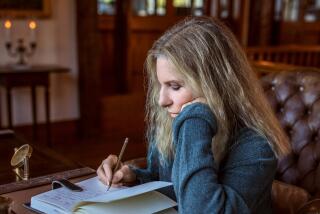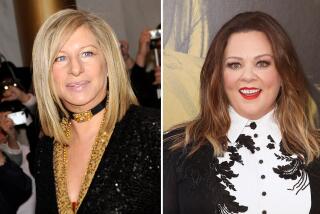The way they are: Adele and Barbra Streisand keep a fading pop-diva tradition alive
A star was reborn when Adele entered the world in 1988, nearly half a century after the birth of the groundbreaking pop diva whose fading tradition Adele upholds more convincingly than any young singer in her generation.
We speak, of course, of Barbra Streisand.
Storytelling instincts, superhuman pipes, refined taste in glittering gowns: These women share so much in common, yet they’ve never performed together in public — and not because Streisand refuses to make room in the spotlight. Next month she’ll put out her second duets album in two years, common-enough projects for an artist at her age and with her wide assortment of friends and admirers.
The two will come close to breathing the same air next week when they play separate concerts at Staples Center in Los Angeles. On Tuesday, Streisand is due to begin a North American tour ahead of the Aug. 26 release of “Encore: Movie Partners Sing Broadway,” which follows 2014’s “Partners” and finds the 74-year-old entertainer performing numbers from musicals like “A Chorus Line” and “Annie Get Your Gun” with help from actors including Hugh Jackman and Melissa McCarthy.
Then Adele, 28, will take over the downtown arena for an unprecedented eight-night stand that starts Aug. 5, part of the British singer’s lengthy world tour behind last year’s blockbuster “25” album.
The shows’ proximity provides an opportunity to consider all that unites Streisand and Adele. But the concerts’ setting at one of modern pop’s prime destinations — the spot where Taylor Swift touched down a year ago for five gigs full of sly pomp and expert flash — also invites us to think about the ways pop diva-dom has changed over the decades since Streisand achieved superstardom, and to what extent Adele’s huge success is a result of her return to an earlier sensibility.
There have been previous near misses between the women (and Columbia Records label mates) whose eventual collaboration seems like a show-business must. For her 2011 album, “21,” Adele recorded an elegant, bossa-nova-style rendition of the Cure’s “Lovesong” that had originally been devised for Streisand.
And both artists sang at the Academy Awards in 2013, after which they were photographed together at the Governors Ball, Adele looking like she’d won a prize more special than the Oscar she was holding.
As they demonstrated that evening, what connects the singers most immediately is the raw vocal ability that puts them in the smallest of classes, especially now that vocal ability has become more of a technological construct — an after-the-fact product of careful digital manipulation — than something related to human physiology.
Listen if you haven’t in a while to one of Streisand’s signature tunes, “People,” from the musical “Funny Girl,” and pay attention to the effortless way she scales the tricky ascending melodic line — it could stir a dead man.
Now cue up “All I Ask,” a stunning ballad from “25” in which Adele expertly navigates a key change that seems, after the song has already pillaged your heart, to open a whole new realm of romantic desperation. In both cases the women are using their extraordinary voices to deliver extraordinary emotions, and they’re doing it in songs that seem expressly built for that purpose.
Adele isn’t the only young singer who can belt at a moment when that particular skill is as irrelevant to the job as it’s ever been. Ariana Grande, for one, has proven herself a true vocal powerhouse — and a far bigger musical-theater nut than Adele.
But most current pop treats the voice as merely part of a busy sonic landscape. On Streisand’s old records — even on her recent ones — singing is the raison d’être, a prioritization that clearly extends through Adele’s relatively uncluttered work.
Which isn’t to say that both women aren’t attuned to shifts in popular taste. After years singing show tunes, Streisand dabbled in rock and soul throughout the ’70s and later went disco (most memorably in “Guilty,” her gossamer duet with Barry Gibb of the Bee Gees).
And between all the stripped-down confessionals, “25” features a collaboration with Swift’s go-to writer-producer, Max Martin, and a track streaked with the ’80s-R&B textures in vogue among the likes of Haim and the Weeknd.
Even when they’re bending toward the mainstream, though, the singers still sound rooted in their own distinct environments — something that separates them from, say, Rihanna, a model of portability capable of beaming herself into a Calvin Harris song with little to no friction. Hearing Adele’s voice, in contrast, means plugging instantly into her matrix.
And it’s those stubbornly resistant personas that really bind her and Streisand, both of whom put across a powerful combination of approachability and magnificence, both totally relatable and deeply unknowable at once.
“When #Adele came over to the house, she was so funny and down to earth,” Streisand wrote on Instagram when she posted that Governors Ball photo of the two of them. “My kind of gal!”
Obviously, the aw-shucks routine is a performance, as indeed it was when Adele told a packed Radio City Music Hall in her recent NBC concert special that she’d been so nervous before show time that she’d started searching for an escape route.
You can think of the titles of each woman’s first three albums in a similar fashion: “The Barbra Streisand Album,” “The Second Barbra Streisand Album” and “The Third Album,” along with “19,” “21” and “25,” each of which advertises Adele’s age when she wrote the record. Looked at one way, the titles are doing away with superfluous pageantry; viewed another, they’re taking for granted the significance of the progression each series describes.
Still, compared with the infallibility projected by other members of pop’s reigning elite — “Take it to another level / No passengers on my plane,” Beyoncé sings in her 2008 song “Diva” — this kind of plain talk feels refreshingly old-fashioned, a welcome vestige of a time when artists could afford to let their guard down without fear of being assailed by so-called haters on social media.
And inside the would-be modesty, needless to say, is an implied boast: I’m so fabulous that I don’t even have to make a show of it.
That’s the quality that comes through in a vintage Streisand video clip that may tell us what to expect if a duet with Adele ever materializes (and perhaps why one hasn’t yet). An excerpt from “The Judy Garland Show” in the early ’60s — when Garland was the established veteran and Streisand the rising phenom — it shows the two joining voices for a savage but somehow casual run through “Happy Days Are Here Again.”
Before they sing, Garland introduces the younger performer by telling her, “We’ve got all your albums at home, you know, and you’re so good that I hate you.”
Streisand laughs insouciantly, confident enough in her own abilities that she hardly feels the need to respond.
She does anyway of course: “You’re so great that I’ve been hating you for years,” she tells Garland. Then the music starts up and each singer eyes the other as though she’s sizing up a meal.
Fast-forward half a century to Streisand and Adele, and it makes you wonder if Staples Center — let alone a little duets album — would be big enough for the both of them.
Twitter: @mikaelwood
More to Read
The biggest entertainment stories
Get our big stories about Hollywood, film, television, music, arts, culture and more right in your inbox as soon as they publish.
You may occasionally receive promotional content from the Los Angeles Times.











